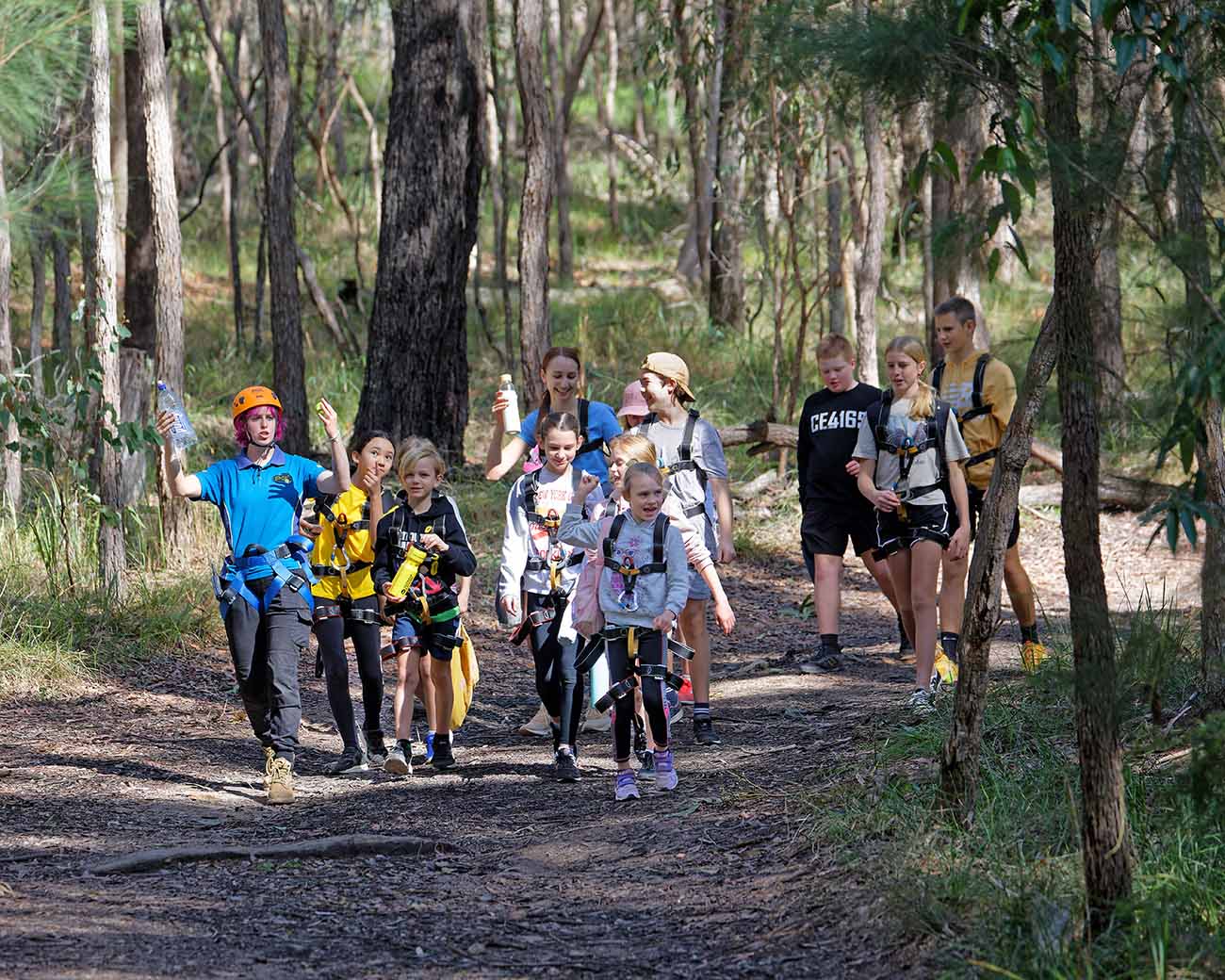Embarking on an adventure trip with your group is such an exciting experience for both kids and adults alike, spending time with like-minded people and learning new skills in the great outdoors while creating memories that last a lifetime.
But group trips can also be complex to organise—especially when balancing different interests, abilities, and logistics. So, if you’re ready to take the plunge and need some help on how to plan a group adventure, you’ve come to the right place!
Whether you’re coordinating a getaway for Girl Guides, a faith-based youth group, a family reunion, or a local sports club, we’ve got a few handy tips and ideas to make it all go smoothly.
Plus, we’ll tell you more about PGL’s outstanding facilities for groups of all types, with tailored holiday packages to meet your precise needs and a range of activities that guarantee both fun and learning!
Why go on group adventure trips?
Beyond just exploring new landscapes, group adventure trips offer a wealth of benefits. These shared experiences can strengthen bonds, develop your personal growth, and give everyone a much-needed mental reset.
Here’s a full stack of reasons why you should take your group into the great outdoors:
Bond with your group
Taking part in various challenges, overcoming obstacles together, and celebrating successes can help strengthen bonds between friends, family, teammates, or peers. Even simply spending quality time away from everyday routines allows deeper relationships to flourish. Laughing around a campfire, hiking on a tricky trail, or working to complete a team-building activity will bring you all a lot closer!
Build confidence
Stepping outside comfort zones and tackling adventurous activities, whether it’s abseiling down a tower or paddling together in a canoe, can significantly build confidence. Overcoming perceived limitations and achieving something new will leave everyone feeling stronger and more capable of taking risks, helping to boost self-esteem and resilience.
Develop leadership and teamwork skills
Group adventure trips naturally present opportunities for leadership skills to emerge and teamwork to thrive. Taking on different roles within the group and sharing responsibilities like setting up a tent or preparing meals together teaches members the value of collaboration, communication and decision-making—all essential qualities of a successful leader.
Connect with nature
There’s no better way to disconnect from the digital world and reconnect with the natural one. Breathing fresh air, observing wildlife, and feeling the earth beneath your feet can be incredibly grounding and rejuvenating. It has been shown to significantly lower cortisol levels, promoting a deep sense of calm. What’s more, spending time in nature nurtures an appreciation for the environment and inspires us to live more sustainably.
Boost mental health
The combination of physical activity, natural beauty, and social interaction is a powerful recipe for improved mental wellbeing, contributing to a positive mindset. Stepping away from daily pressures of modern life, engaging in fun outdoor activities, and connecting with others can reduce stress, anxiety, and improve our overall mood.
Have fun!
Above all else, group adventure trips are about having fun and creating lasting memories. The thrill of new experiences, the inside jokes formed along the way, or the sense of collective achievement from smashing through a pre-season training session, all blend into an unforgettable adventure.
Five steps on how to plan a group trip
Now that you’re sold on the “why,” let’s dive into the “how”. From setting goals to picking a destination, organising activities, and making sure everyone stays safe and happy, there’s a lot to consider. But with the right approach, it can be just as enjoyable as the trip itself.
Without further ado, here is a step-by-step breakdown of planning an epic group adventure trip!
1. Outline your goals
Before even thinking about destinations or activities, the first crucial step is to clearly define the goals of your trip. What do you hope your group will gain from this adventure? Some examples of what different types of groups might be aiming to achieve include:
- For Girl Guides: Is the focus on developing specific outdoor skills like knot tying and bushcraft, possibly earning a new badge (e.g. Leadership, Camping, Safety, etc.) or building teamwork?
- For church and faith groups: Is the aim to deepen spiritual connections through nature, build fellowship and community, offer opportunities for reflection, or engage in service-oriented activities?
- For families: Are you looking to create new family memories, introduce children to the outdoors, or simply enjoy quality time away from everyday distractions?
- For sports clubs: Is the goal to build team cohesion outside of the usual sporting environment, improve passing accuracy or choreography, celebrate a win, or enjoy a social outing?
- For charity and community groups: Are you aiming to raise awareness for a cause through an adventurous challenge, build camaraderie among volunteers, offer a unique experience for beneficiaries, or engage in environmental conservation efforts?
Understanding your goals will inform every subsequent decision and set the overall tone and focus of your trip. It’s also worth involving your group in this initial brainstorming process to make sure everyone feels invested and that the trip hits the mark with your objectives.
2. Choose a destination
Next is picking the right destination for your group’s adventure. Luckily, Australia boasts an incredible range of locations for all types of experiences. Consider the following factors when selecting your destination:
- Suitability for your group: Consider the age range, fitness levels, and any physical limitations within your group. A challenging hike might be perfect for a fit sports club but less suitable for a family with young children or varying mobility levels.
- Alignment with your goals: Does the destination offer the types of activities that align with your trip’s objectives? If your goal is to connect with nature, a remote area would be ideal.
- Accessibility and logistics: How easy is it to reach the destination? Consider travel time, the availability of necessary amenities like accommodation, food, and access to supplies.
- Budget: Different destinations have varying costs associated with permits, accommodation, activities, and travel. Establish a realistic budget early on and choose a place that fits within your financial constraints.
- Time of year: Australia’s climate varies across regions and seasons. Summer (December to February) can bring extreme heat, making water activities like canoeing or raft building ideal, while winter (June to August) is better for land-based activities. Always check the weather for your destination to ensure conditions suit your planned activities.
- Specific interests: Consider any specific interests within your group. Are they interested in wilderness survival? If so, then a bushcraft activity like shelter building could be the perfect fit for your group.
No matter what your preference, there’s a place out there to suit every group. At PGL, we have three adventure camps for groups that offer brilliant facilities and accommodations to make your visit a bit more special. Check out the individual camp pages for more information:
PGL Campaspe Downs (VIC), PGL Camp Rumbug (VIC) and PGL Camp Kindilan (QLD).
3. Plan adventurous activities
Now comes the fun part – planning the activities that will make your group adventure trip truly unforgettable! You might choose to go out and see local landmarks, or opt to stay together and enjoy a bushwalk. If you book a group camp with PGL, here is a selection of some of the adventurous activities available:
- Flying Fox: A thrilling zip-line ride where participants glide from a height to the ground. It helps build confidence, trust, and teamwork as they support each other, and it’s an exciting way to challenge personal limits.
- Abseiling: Descend from a tower using ropes and controlled techniques under the guidance of qualified instructors. This activity will help boost your group’s self-confidence and encourage people to conquer their fears.
- Bushcraft: Learn essential survival skills like shelter building, water filtration and signalling. It’s a great way to enhance teamwork while building self-reliance in the great outdoors.
- Challenge Course: A series of obstacles that require problem-solving and coordination to navigate your way through successfully.
- Aeroball: For some friendly competition, this unique game combines elements of volleyball and trampolining. The aim? Get the ball in the opposing team’s net.
- Leap of Faith: Rely on the support and encouragement of your group to jump from a platform and touch the suspended ball. This is the perfect activity for building confidence and supporting one another.
- Raft Building: Teams design and build their own raft using different components, then race them on the water. It requires teamwork, leadership skills and a whole heap of fun!
- Archery: Take aim and learn precision, focus, and resilience with this classic activity. Suitable for all skill levels, it helps build hand-eye coordination and self-discipline.
Plus many, many more!
4. Create a packing checklist
Packing can make or break an adventure trip for your group, so it’s essential to be prepared. Create a comprehensive checklist tailored to your specific destination, activities, sport, or club (if applicable), and the time of year. This may include:
Individual items:
- Suitable clothes: Quick-dry t-shirts, long-sleeve tops, lightweight hiking pants or leggings, a warm jumper or fleece, a rain jacket, a hat, and sturdy walking shoes or hiking boots. Include extra socks and underwear for comfort.
- Sleeping bag and mat: A sleeping bag suitable for the temperature, a tent, and a foam or inflatable sleeping mat for insulation and comfort on cold ground (if camping).
- Water bottle: A reusable, BPA-free water bottle (at least 1–2 litres capacity).
- Torch/headlamp: An LED headlamp with fresh batteries for night-time, especially useful for toilet trips. A small handheld torch is also handy as a backup.
- Toiletries: Include soap, toothbrush and toothpaste, small towel, deodorant, toilet paper, and hand sanitiser to stay fresh and maintain good hygiene.
- Sunscreen and insect repellent: SPF 50+ sunscreen and DEET- or picaridin-based insect repellent, especially in bush or coastal areas where mozzies are common.
- Medication: Any personal medications like antihistamines, motion sickness tablets, or asthma inhalers. Always label and store them safely, especially when travelling with a group.
Group items:
- First aid kit: Bandages, antiseptic wipes, plasters, gauze, gloves, tweezers, burn cream, and insect sting relief.
- Activity-specific gear: Bring gear tailored to your trip! For sports clubs, this might include training cones, resistance bands, balls, and team uniforms. Girl Guides may need compasses or badge books, whereas families may pack bikes and games.
- Food and snacks: To keep energy levels up between activities, pack a few extra snacks such as muesli bars, trail mix, dried fruit, or crackers. PGL camps offer three nutritious, well-balanced meals daily, with a range of options to cater to various dietary needs—check out our sample menu for details. Additionally, please inform us of any dietary restrictions or religious food requirements in your group.
For more information on what to pack for a group camp adventure, see our helpful packing list guide.
5. Don’t Forget Health & Safety!
While group adventure trips are all about pushing boundaries and having fun, safety should always be a top priority. Make sure you’ve ticked all these boxes:
- Risk assessment: Conduct a thorough risk assessment of all planned activities and locations. Identify potential hazards and implement strategies to mitigate them. If you book a group camp with PGL, all of this is taken care of for you for added peace of mind.
- First aid and medical information: Make sure you have a well-stocked first-aid kit and that someone is trained in basic first aid. Collect essential medical information from all group members, including allergies and pre-existing conditions.
- Emergency procedures: Establish clear emergency procedures and ensure everyone knows what to do in case of an accident or unexpected situation. Have contact information for local emergency services readily available (again, this is all taken care of for you on a PGL camp).
- Communication plan: In areas where mobile phone reception may be limited, consider alternative options such as satellite communication devices or two-way radios for remote locations. At PGL, all our centres are equipped with Wi-Fi access, so you’ll never be out of reach when it matters most.
- Insurance: Get adequate travel insurance that covers all participants for the activities and potential medical emergencies.
As a member of the Australian Camps Association, PGL undertakes Essential Safety Measures compliance annually, which ensures that our adventure camps are well-maintained and safe for all participants.
Ready for a group adventure at PGL?
With your goals outlined, destination chosen, activities planned, and checklist ready, you’re well-prepared for the adventure of a lifetime!
So gather your group – family and friends, Girl Guides, faith group, sports team, or work colleagues – and set forth on an epic group camp trip that will leave you feeling exhilarated, empowered, and connected to nature and each other!
Also, check out our other options for holiday camps or school camps for primary schools and secondary schools, where endless possibilities await!
To make a booking, organise a group trip, or for more details, contact us today at 1300 859 895. We would love to hear from you!

A qualified teacher and former university lecturer, Steve has been our Guest Experience Manager at Campaspe Downs for many years. Steve’s work at Victoria University, setting up the “Iramoo Sustainability Centre”, focused on restoring and protecting the native grasslands of western Victoria, as well as advising schools how to set up indigenous gardens. He has lectured on science, indigenous education and outdoor education.









